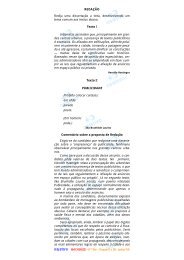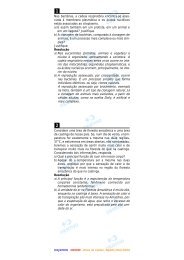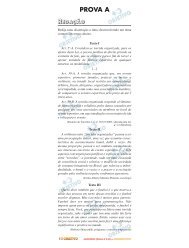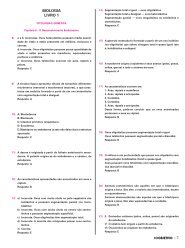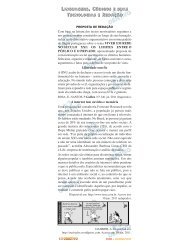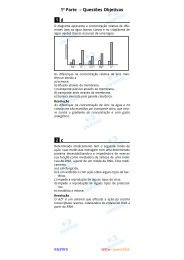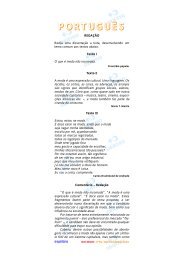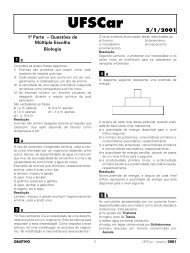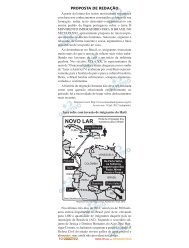001. Caderno 1 Provas da 1.a Fase Matemática ... - Curso Objetivo
001. Caderno 1 Provas da 1.a Fase Matemática ... - Curso Objetivo
001. Caderno 1 Provas da 1.a Fase Matemática ... - Curso Objetivo
Create successful ePaper yourself
Turn your PDF publications into a flip-book with our unique Google optimized e-Paper software.
82. The last sentence of the text implies that investors<br />
(A) have been very distressed with European banks since<br />
2008.<br />
(B) may even lose their health due to the difficult situation<br />
of European banks.<br />
(C) are now showing the same signs that have been shown<br />
since 2008.<br />
(D) are now more concerned with the European bank situation<br />
than they have been for a couple of years.<br />
(E) have reached their bottom line as far as the health of<br />
European banks is concerned.<br />
Leia o texto a seguir e respon<strong>da</strong> às questões de números 83 a 90.<br />
Oct 29th 2011 | BRASÍLIA<br />
FGVS1101/002-Cad2-tarde<br />
Blurring the man<strong>da</strong>te<br />
Is the Central Bank targeting growth?<br />
For much of the last century inflation was as prominent a<br />
feature of Brazilian life as football. It was finally tamed, first by the<br />
Real Plan of 1994 involving a new currency and fiscal measures,<br />
and then from 1999 by requiring the Central Bank, which was<br />
granted operational independence, to set interest rates to meet<br />
an inflation target. Since 2005 that target has been 4.5%, plus<br />
or minus two percentage points. So the Central Bank surprised<br />
everyone in August when it cut its benchmark rate by half a point<br />
(to 12%) even though inflation was then at 6.9%. On October 19th,<br />
the bank did the same again. So is the government of President<br />
Dilma Rousseff, in office since January, giving priority to other<br />
goals, such as sustaining growth and preventing the overvaluation<br />
of the currency, rather than keeping inflation low? And has the<br />
Central Bank lost its independence?<br />
No, say officials, who cite two sets of reasons for the rate cuts.<br />
First, having overheated last year, the economy stalled in the third<br />
quarter, partly as a result of earlier interest-rate rises and modest<br />
fiscal tightening. The consensus forecast is for GDP to expand by<br />
only 3.3% this year. Second, the bank argues that inflation was<br />
boosted by one-off factors, such as big rises in municipal bus fares<br />
and a shortage of ethanol. In the minutes of its August meeting,<br />
the bank’s monetary-policy committee stated that the deteriorating<br />
outlook for the world economy and falling commodity prices would<br />
put downward pressure on prices in Brazil, allowing inflation to<br />
reach the 4.5% target in the course of next year.<br />
There are indeed signs that inflation is starting to fall. But the<br />
government’s critics argue that by starting to cut so early and so<br />
aggressively, while inflation is still almost three points above the<br />
target, the bank has <strong>da</strong>maged its hard-won credibility. As a result,<br />
inflation expectations for the years ahead are rising. The minimum<br />
wage is due to rise by 14% or so in January and unemployment<br />
remains low. The biggest problem is that some prices and wages<br />
are indexed to last year’s inflation, a hangover from the past.<br />
The bank may yet be vindicated by outside events and turn<br />
out to have provided Brazil with a soft landing. As inflation falls,<br />
expectations will quickly follow, says Nelson Barbosa, the deputy<br />
finance minister. Certainly lower interest rates would help the<br />
country. Among the reasons why they are so high—including<br />
government borrowing, taxes on credit, and lack of competition<br />
in banking—the most powerful may be sheer inertia.<br />
4<br />
In a vicious circle, high rates depress investment, add to<br />
the government’s borrowing costs (which total some 5% of<br />
GDP) and thus its fiscal deficit (of over 2% of GDP). They also<br />
attract hot money from abroad, which has helped to make the<br />
real uncomfortably strong, hurting exporters. “We are in a bad<br />
equilibrium,” says Mr Barbosa. “We can live with this exchange<br />
rate with a lower interest rate, but not with this interest rate. One<br />
of them has to go.”<br />
The government wants the real interest rate to fall to 2%-3%,<br />
but Mr Barbosa insists this is not a formal target. If inflation rises,<br />
the bank will hike rates again, he says. Some other central banks,<br />
including America’s Federal Reserve, have a man<strong>da</strong>te to pursue<br />
both growth and low inflation. But when it comes to inflation,<br />
Brazil is a recovering alcoholic. It needs its Central Bank to keep<br />
it on the straight and narrow.<br />
(www.economist.com/node/21534796. A<strong>da</strong>pted)<br />
83. The first paragraph of the text<br />
(A) shows that the main goal of the present Brazilian<br />
administration is to curb inflation as never really done<br />
before 1994.<br />
(B) questions whether the Brazilian Central Bank is being<br />
directly controlled by the Rousseff administration.<br />
(C) implies that Brazilian inflation began to be controlled<br />
only in the 21st century.<br />
(D) says that the cut of the Central Bank’s benchmark rate<br />
in August had been expected since the beginning of the<br />
Rousseff administration.<br />
(E) states that the benchmark rate was cut by half a point<br />
in order to adjust inflation, which had reached 6.9% in<br />
August.<br />
84. De acordo com o texto, o Banco Central do Brasil<br />
(A) afirma que o aumento do álcool combustível elevou a<br />
tarifa dos ônibus municipais.<br />
(B) cortou as taxas de juros para tentar melhorar as previsões<br />
do crescimento do PIB para 2011, que é de 3,3%.<br />
(C) prevê que a inflação em 2012 estará dentro <strong>da</strong> meta<br />
estabeleci<strong>da</strong> em 2005.<br />
(D) ordenou ao COPOM (Comitê de Política Monetária) que<br />
reduzisse a pressão dos preços na economia.<br />
(E) tenta controlar o preço <strong>da</strong>s commodities brasileiras por<br />
meio <strong>da</strong>s taxas de juros estabeleci<strong>da</strong>s pelo COPOM.<br />
85. Segundo os dois parágrafos iniciais do texto,<br />
(A) o Brasil conviveu com o problema <strong>da</strong> inflação ao longo<br />
de quase todo o século XX.<br />
(B) as medi<strong>da</strong>s fiscais implanta<strong>da</strong>s pelo Plano Real acabaram<br />
sendo bastante modestas.<br />
(C) o governo de Dilma Rousseff estabeleceu a meta inflacionária<br />
de 4,5%, aceitando pequenas variações.<br />
(D) as perspectivas <strong>da</strong> economia mundial estão sendo analisa<strong>da</strong>s<br />
pelo COPOM desde agosto passado, a pedido do<br />
governo de Dilma Rousseff.<br />
(E) há um consenso de que o PIB de 2011 não aumentará<br />
mais de 3,3% neste ano devido ao aumento <strong>da</strong> inflação.



